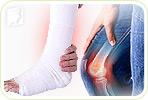Osteoporosis is a serious symptoms of menopause. Medical practitioners recognize many women suffer from osteoporosis during their lifetime. The symptoms of osteoporosis can be severe and dangerous if not treated. To avoid the debilitating effects of osteoporosis, learn about estrogen and osteoporosis.
What Is Osteoporosis?
Osteoporosis is a degenerative bone disorder causing bones to thin and weaken. It's characterized by a decrease in overall bone mass and density.
Quick Fact:
On average, humans lose about 1% of bone mass every year. During menopause, this accelerates to between 2% to 7%.
Bones are composed for two major elements: minerals, calcium, and phosphorous; and bone cells called osteoblasts and osteoclasts. Osteoclasts break down the bone and osteoblasts rebuild them. To maintain healthy bones, both the osteoclasts and the osteoblasts need to work in harmony.
Osteoporosis makes bones more fragile and more susceptible to fractures and breaks. Wrists, spine, and hips are the most vulnerable bones, often breaking easily after a fall or a minor accident.
Osteoporosis and Estrogen: The Link
Ovaries decrease production of the hormone estrogen during menopause.Decreased estrogen levels accelerates bone loss for a period of about five to eight years.
Quick Fact:
Estrogen replacement during menopause protects bone mass and helps protect against the risk of osteoporotic fractures.
The lack of estrogen enhances the ability of osteoclasts to absorb bone. However, osteoblasts (i,e; cells which produce bone) don't rebuild more bone. This results in bone loss and osteoporosis.
Accelerated bone loss during menopause has little relationship to the amount of calcium intake. Despite this, increased calcium consumption after the age of 60 can improve bone density. Other less frequently referred to causes of bone loss include deficiencies in vitamin D, a lack of muscle, and certain medications.
How to Manage Estrogen and Osteoporosis
Quick Fact:
Prior to menopause, check your bone health with your doctor. When done early on, you can help prevent and treat osteoporosis.
Preventing osteoporosis is far easier and far more desirable than treating it. The first step in preventing osteoporosis is to control estrogen and calcium levels.
Maintaining a healthy diet and exercise routine is imperative, as well as getting sufficient calcium in your diet. There is also a range of pharmaceutical drugs and alternative medicines that target calcium depletion and can prevent osteoporosis.
Sources
- "Menopause and Osteoporosis". Cleveland Clinic. http://my.clevelandclinic.org
- "What You Need to Know about Osteoporosis". American Physical Therapy Association. www.apta.org.
- "Calcium and Healthy Bones". New York State Department of Health. www.health.state.ny.us.
- "Prevention: Who's at Risk". National Osteoporosis Foundation. www.nof.org.



